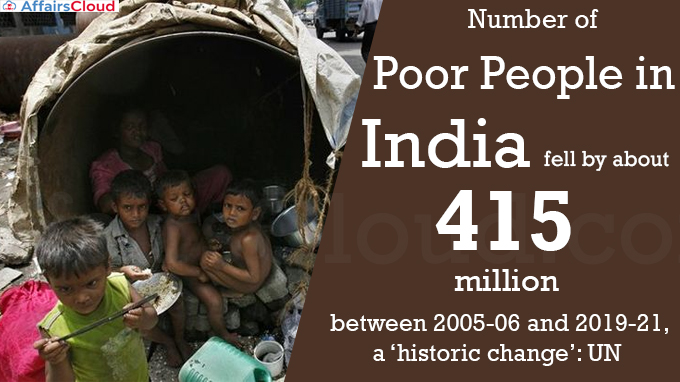 According to the Global Multidimensional Poverty Index 2022, which is titled “Unpacking Deprivation Packages to Reduce Multidimensional Poverty”, 415 million people in India have been able to liberate from poverty over a 15-year period between 2005–2006 and 2019–21, which is a “historic change.”
According to the Global Multidimensional Poverty Index 2022, which is titled “Unpacking Deprivation Packages to Reduce Multidimensional Poverty”, 415 million people in India have been able to liberate from poverty over a 15-year period between 2005–2006 and 2019–21, which is a “historic change.”
- The report is based on India’s 2020 population data.
The report was released by the Oxford Poverty and Human Development Initiative (OPHI) and the United Nations Development Programme (UNDP) at the University of Oxford.
Significance
It highlights that the Sustainable Development Goal (SDG) target 1.2, which calls for lowering by at least half the proportion of men, women, and children of all ages living in poverty in all of its manifestations by the year 2030, is both feasible and achievable.
Global Multidimensional Poverty Index (MPI)
The Global Multidimensional Poverty Index (MPI) is a significant global resource that assesses acute multidimensional poverty in over 100 developing countries.
- It was first introduced in 2010 by the OPHI at the University of Oxford and the Human Development Report Office of the UNDP.
It advances Sustainable Development Goal 1 by holding the international community responsible for its commitment to eradicating poverty in all of its forms worldwide.
Global level
i.Sub-Saharan Africa (almost 579 million) and South Asia (385 million) are home to the majority of multidimensionally poor people (83%).
ii.Two-thirds of the poor live in middle-income countries, while 83% live in rural areas.
iii.According to the report, based on 2020 population data, India has by far the largest poor people in the world (228.9 million), followed by Nigeria (96.7 million projected in 2020).
iv.According to the report, 1.2 billion people—or 19.1% of the world’s population—live in acute multidimensional poverty across 111 countries. Half of these people (593 million) are children under the age of 18.
v.The most common profile, which affects 3.9 % of the poor, comprises deprivation in four indicators: nutrition, cooking fuel, sanitation, and housing.
- Only these four indicators are prohibited to more than 45.5 million poor people.
vi.This profile is primarily South Asian considering 34.4 million of those people reside in India, 2.1 million in Bangladesh, and 1.9 million in Pakistan.
Key Report Statistics for India:
i.Despite the fact that child poverty decreased more quickly in absolute terms, there were still 97 million poor children in India in 2019–21 (or 21.8% of all children aged 0–17).
- It is more than the total number of poor people, children and adults combined in any other nation covered by the global MPI.
ii.Subnational regions that were formerly among the poorest in their country reduced poverty rapidly in absolute terms than the national average, minimizing the poverty gap.
- These include India’s Bihar, Jharkhand, and Uttar Pradesh (2015/2016 – 2019/2021).
iii.Nearly 415 million people in India escaped poverty in the 15 years preceding the COVID-19 pandemic, with 275 million achieving it between 2005/2006 and 2015/2016, and 140 million achieving it between 2015/2016 and 2019/2021.
iv.According to data from the 2019–2021 Demographic and Health Survey, an estimated 16.4% of Indians live in poverty, with an average level of 42 %.
v.In rural areas, 21.2% of people are poor, compared to 5.5% in urban areas.
- Rural areas are clearly a priority as they are home to approximately 90% of the poor: 205 million of the 229 million poor people live in.
vi.India is the only country in South Asia where families headed by women are much more likely to be poor than those headed by men.
- Approximately 19.7% of people in female-headed households are poor, compared to 15.9% of people in male-headed households.
- Around 39 million poor people live in households with a female head of household, which makes up one in seven households.
vii.The MPI value decreased the fastest in absolute terms in Bihar, the poorest state in 2015–2016.
- Poverty decreased from 77.4 % in 2005/2006 to 52.4 % in 2015/2016 and 34.7 % in 2019/2021.
viii.Goa experienced the fastest relative decline among Indian States/Union Territories, followed by Jammu & Kashmir, Andhra Pradesh, Chhattisgarh, and Rajasthan.
ix.West Bengal, which was one of the 10 poorest states in 2015-2016, is no longer one of the ten poorest in 2019-2021.
- The remaining states, including Bihar, Jharkhand, Meghalaya, Madhya Pradesh, Uttar Pradesh, Assam, Odisha, Chhattisgarh, and Rajasthan, continue to remain among the 10 poorest.
Click Here to Read More About India Specific Data
Recent Related News:
As per the report ‘Human Development Report 2021-22- Uncertain Times, Unsettled Lives: Shaping our Future in a Transforming World’, by the UNDP, India ranked 132nd among 191 countries and territories on the 2021 Human Development Index (HDI). In the 2020 report, India had ranked 131st among 189 countries and territories.
About United Nations Development Programme (UNDP):
Administrator– Achim Steiner
Establishment – 1945
Headquarters– New York, United States




